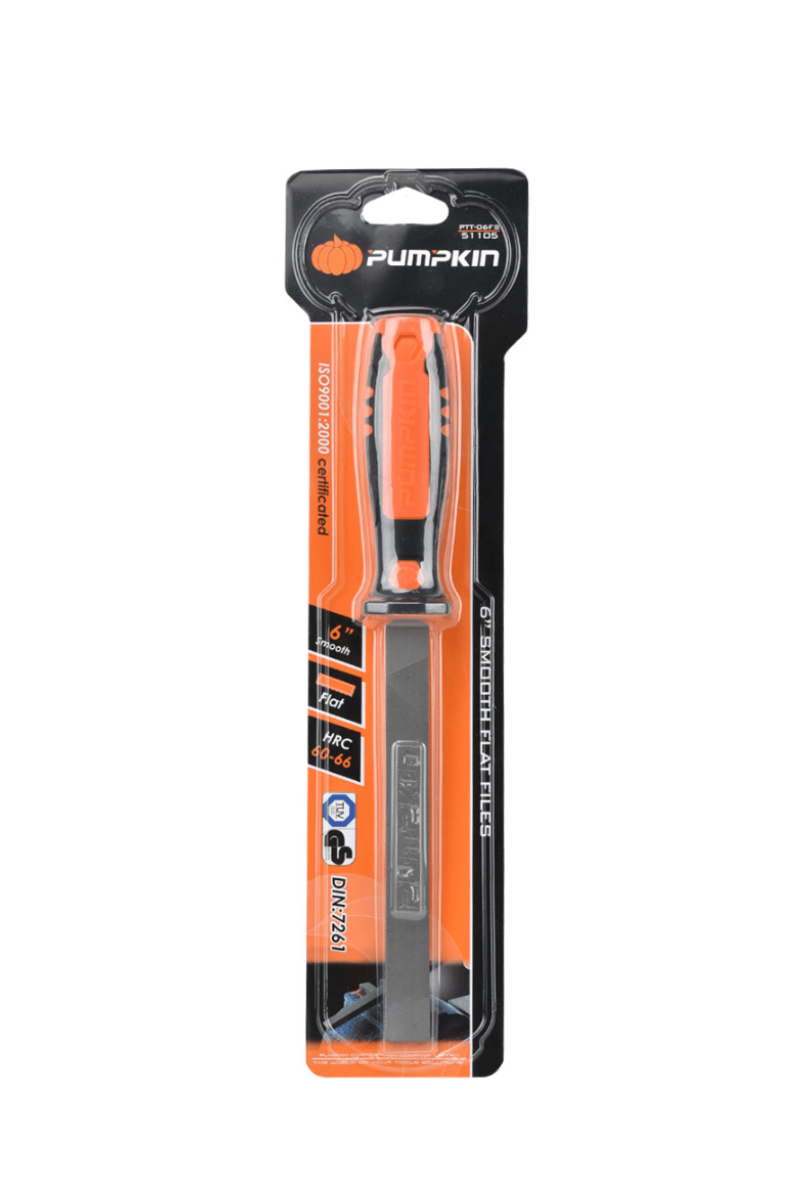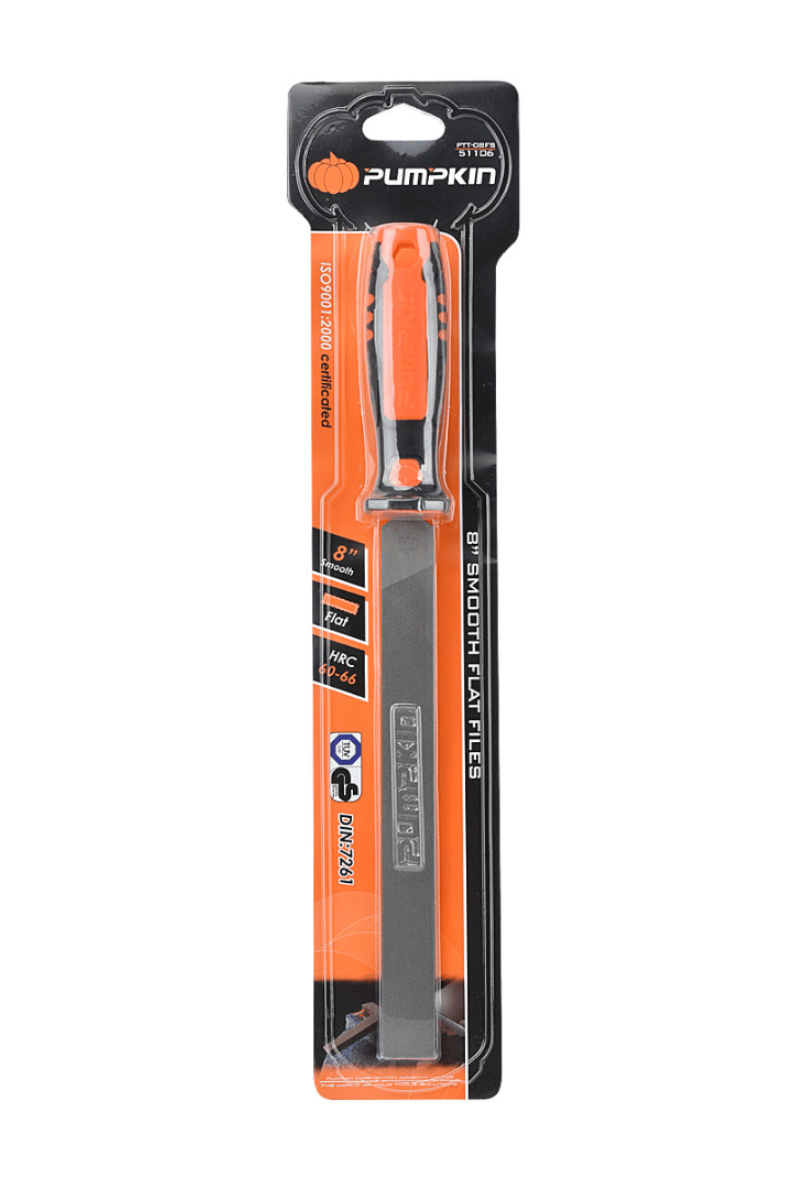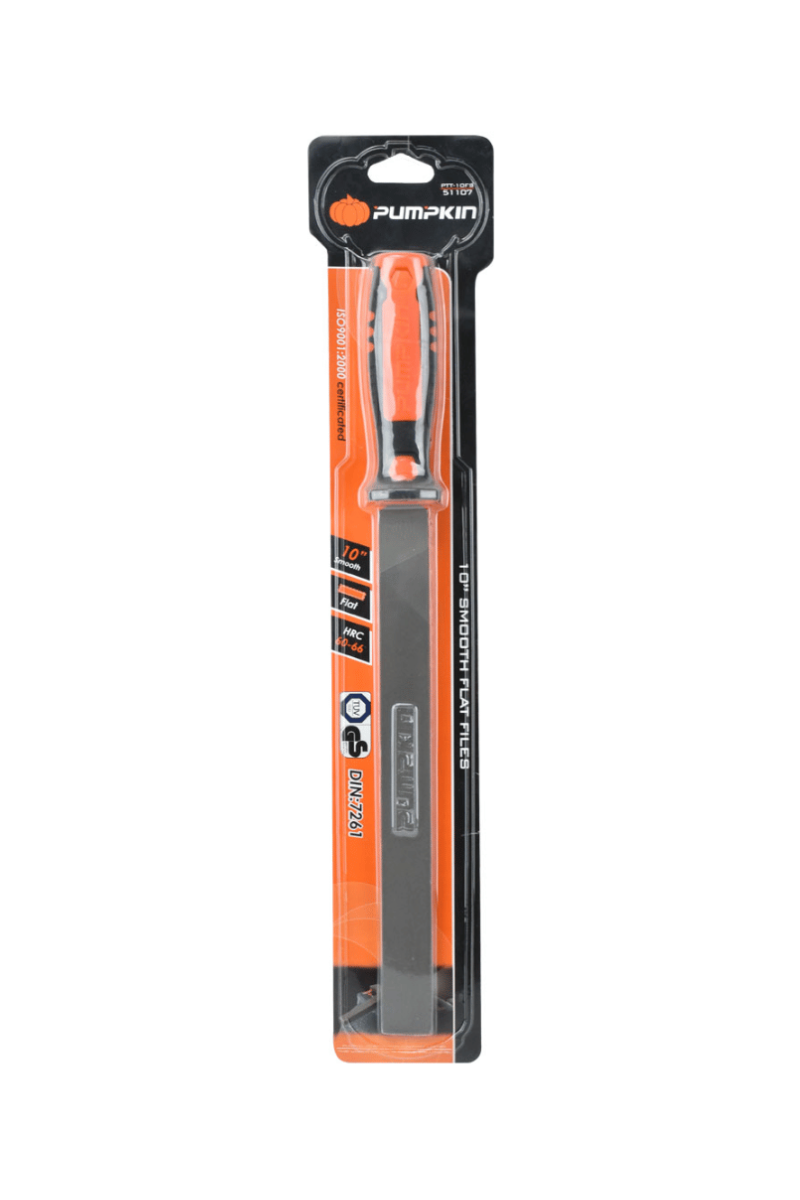File: A Basic Hand Tool for Professionals
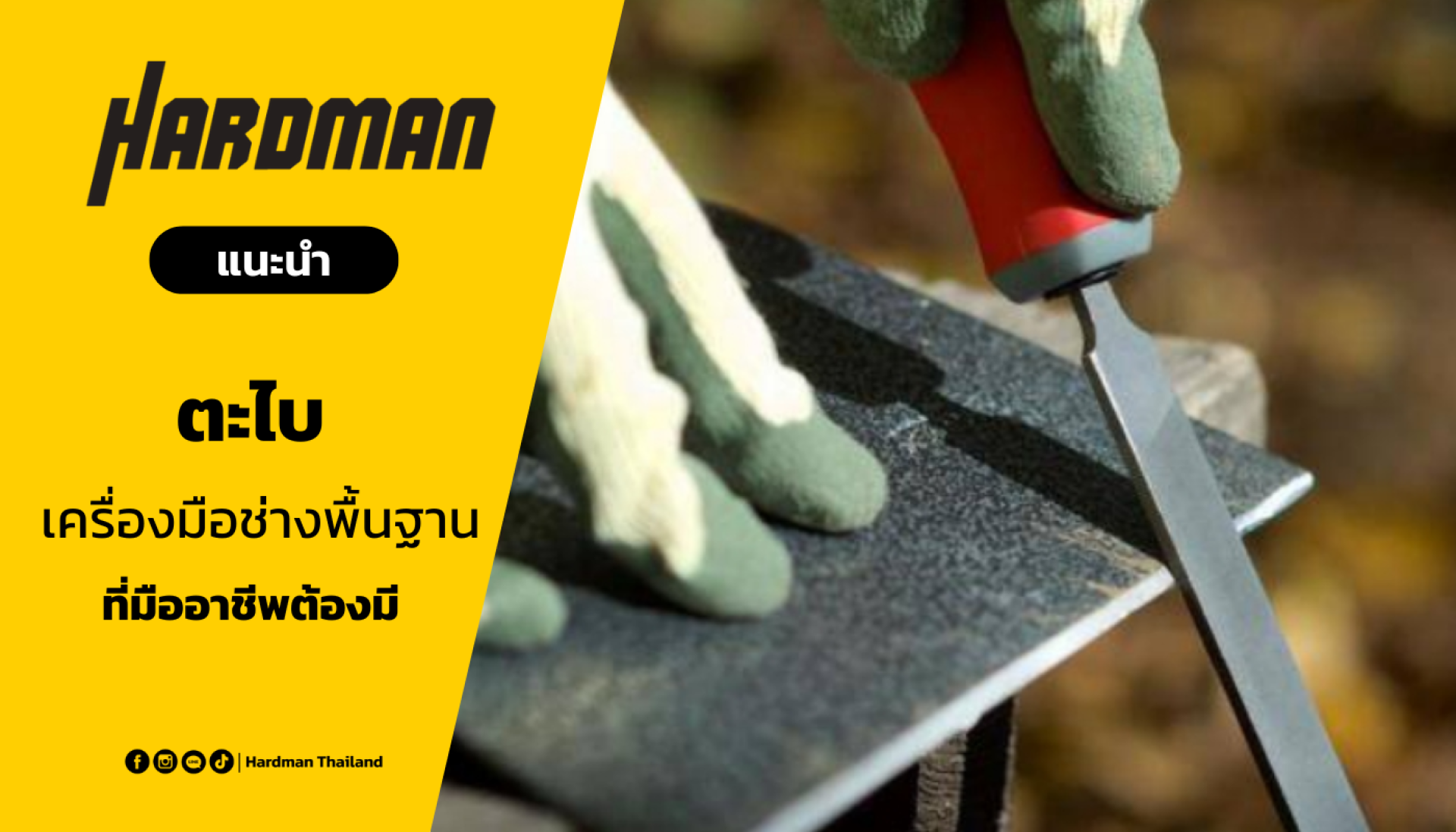
A file is a tool made from high-carbon steel, with its surface featuring sharp cutting edges commonly known as "file teeth." These teeth are used for finishing, shaping, or smoothing rough surfaces of a workpiece. Files typically have a handle made of wood or plastic for a comfortable grip, often cylindrical for ease of handling.
What is a
A file is a hand tool used for grinding, rubbing, or finishing the surface of a material to make it smooth, remove sharp edges, or reduce the size of a workpiece as needed. It's commonly used with various materials such as metal, wood, and plastic. Its primary function is to "abrade the surface" little by little through its sharp, grooved surface. The file is a versatile hand tool often found in general workshops for tasks like maintenance, metalwork, woodworking, model making, and various craft projects.
Types of Files and Their Uses
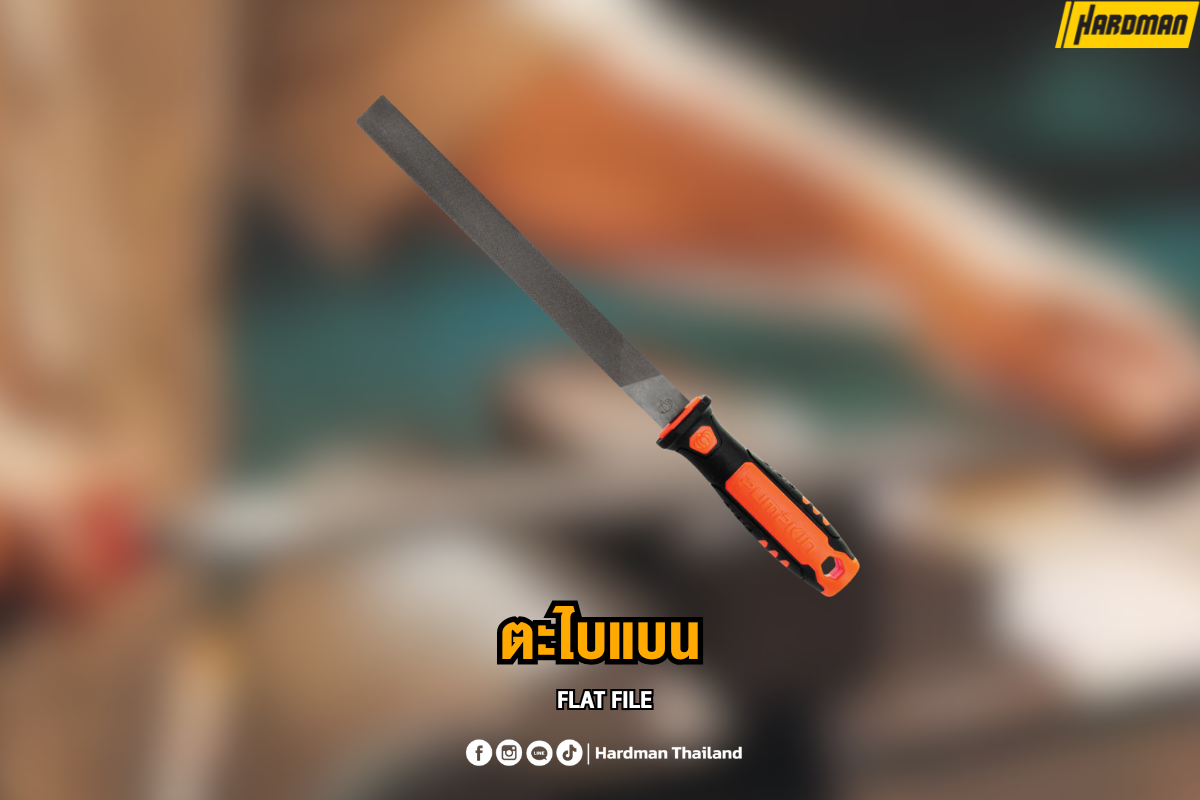
1. Flat File
Key Features: The flat file is the most common and familiar type of file. It has a rectangular cross-section, and some variations may taper slightly towards the tip for easier access into narrow corners. The teeth on flat files range from very coarse cut (for aggressive material removal) to very smooth cut (for fine finishing and smoothing surfaces).
Uses:
- Surface Finishing: Best suited for smoothing and leveling surfaces, such as removing scale or rust from metal surfaces, or evening out uneven planes.
- Deburring: A primary task for flat files is removing burrs created by cutting, drilling, or forming metal. This prevents injury and gives the workpiece a clean finish.
- Reducing Workpiece Size: Can be used to slightly reduce the thickness or width of a workpiece, especially with softer materials like wood, plastic, or aluminum.
- Usage Technique: Hold the file firmly with both hands: one hand on the handle and the other supporting the tip. Apply pressure while pushing the file forward (the "stroke") along the full length of the file's teeth. Lift the file slightly when drawing it back to prevent rapid tooth wear and avoid damaging the workpiece. You should file in straight lines, alternating with slight diagonal strokes, to prevent straight line marks on the material.
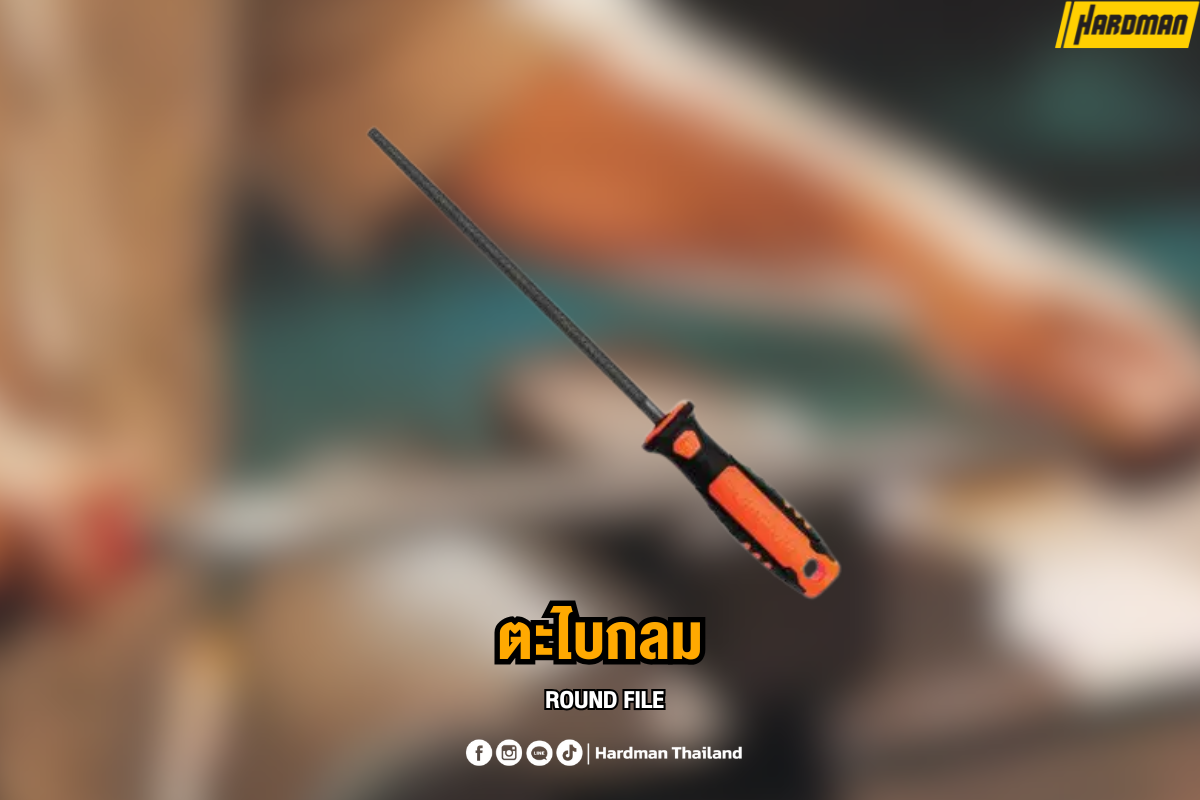
2. Round File
Key Features: This file has a circular cross-section along its entire length, sometimes tapering slightly towards the tip. Round files come in various diameters, making them suitable for different hole sizes and curved work.
- Enlarging and Shaping Round Holes: It's an indispensable tool for enlarging pre-drilled holes or reshaping irregular holes to make them perfectly round and to the desired size. For example, you can use it to enlarge bolt holes that require specific tolerances or to refine circular openings in metal sheets.
- Finishing Curved Sections: Use it to finish, refine, or create various curved sections on a workpiece, such as rounding off edges or smoothing the inside of curved grooves.
- Usage Technique: Insert the file into the hole or opening you want to work on. Then, apply pressure and rotate the file back and forth while pushing it in and out. Rotating the file helps its teeth abrade the material evenly, resulting in a smooth, round hole.

3. Square File
Key Features: The square file has a square cross-section with four distinct, sharp corners. Its size is typically indicated by the width of its cross-section.Uses:
- Shaping Square Holes and Right-Angle Grooves: This file is specifically designed for shaping and refining square-shaped holes or slots, such as keyways in shafts, or for creating precise internal right angles in a workpiece.
- Cleaning and Finishing Corners: You can use it to clean and refine the details of internal corners that other file types can't reach, or to sharpen the edges of internal angles for a crisp finish.
- Usage Technique: Similar to using a flat file, hold it firmly and push it forward. Try to keep the file perfectly aligned with the corner or groove you're working on to achieve precise, right-angled corners.

4. Half-Round File
Key Features: This file is exceptionally versatile due to its dual-faced cross-section. One side is flat, much like a flat file, while the other side is half-circular, resembling a leech's belly.Uses:
- Versatile: This is a widely popular file among tradespeople because it can handle a variety of tasks without frequently switching tools.
- Flat Side: Used for smoothing flat surfaces, finishing edges, and deburring, similar to a general flat file.
- Curved Side: Ideal for shaping curved surfaces or enlarging holes to a desired curve, as well as refining various curved openings.
- Combined Use: Perfect for workpieces that feature both curved and flat sections requiring meticulous detail, such as wood carving or intricate metalwork.

Uses:
- Shaping and Sharpening Angles and Grooves: It's the perfect tool for shaping or sharpening angles that require extreme sharpness, such as V-grooves or sharpening the teeth of hand saws.
- Saw Sharpening: This file is widely used for sharpening various types of saws, especially hand saws, where the file's angle perfectly matches the saw teeth's angle, restoring their sharpness and efficiency.
- Accessing Restricted Areas: Due to its pointed tip, it excels at reaching and working in tight spaces or corners that are difficult to access with other types of files.

Key Features: This is a specialized file that is small, round, and has precisely designed cutting teeth specifically for sharpening chainsaw chains. Its diameter is typically specified accurately in millimeters or inches.
Uses:
- Chainsaw Sharpening Only: The sole purpose of this file is to restore the sharpness of worn chainsaw teeth. Consistent sharpening is extremely important for both the efficiency and safety of using a chainsaw.
- Sharpening Technique: Sharpening a chainsaw must be done correctly. Push the file in the same direction as the cutting edge of the saw tooth and maintain the correct sharpening angle as recommended by the chainsaw manufacturer (usually found in the manual) to achieve the optimal cutting edge.
- Maintenance: Regular sharpening helps extend the lifespan of both the chain and the chainsaw itself. It also reduces the load on the engine and makes cutting more efficient.
Precautions for Using Files
Using a file might seem simple, but there are actually several precautions often overlooked. Ignoring these can lead to poor results on your workpiece, or even danger to yourself. Here's what you shouldn't overlook
1. Not Cleaning the File Regularly
This is one of the most common mistakes. As you file, small metal or wood chips get clogged in the file's teeth. Here's what happens
- File doesn't cut: The file becomes dull and can't effectively cut the material, forcing you to apply more pressure.
- Scratches on the workpiece: Clogged material on the file's teeth will scratch your workpiece, creating unwanted marks, especially on softer materials like aluminum or copper.
- Rapid wear of the file: Forcing a clogged file will cause its teeth to wear down and dull faster than usual.
Solution: Regularly use a wire brush or a specialized file card to clean the file's teeth, especially when you feel the file isn't cutting anymore.
2. Applying Pressure While Pulling the File Back
Many people mistakenly believe that filing involves pushing and pulling with equal force. This is something you should absolutely avoid.
- File will dull quickly: The teeth of a file are designed to cut only when pushed forward. Applying pressure while pulling the file back will cause the cutting edges to wear down and dull much faster than they should.
- No benefit: Pulling back with pressure doesn't remove any material; it only damages the file unnecessarily.
Solution: Apply pressure only when pushing the file forward. When pulling the file back, lift the file slightly above the workpiece or release all pressure.
3. Not Securing the Workpiece Tightly Enough
Holding the workpiece by hand while filing, or not securing it firmly, can lead to several problems
- Workpiece Movement: This makes it impossible to control the filing direction accurately, potentially leading to distorted or off-size work.
- Danger: The workpiece might slip from your hand, fly off, or cause the file to slip and cut your hand.
- Poor Quality Work: The surface won't be smooth or flat as desired.
Solution: Use a vise or clamp to secure the workpiece firmly, steadily, and at an appropriate working height.
4. Using the Wrong Type of File for the Material
Using the incorrect file type for your material can damage your workpiece.
- Using a coarse file on delicate work: This creates deep scratches on the workpiece, making it difficult to fix and requiring significant time for finishing.
- Using a fine file on coarse work: The file won't remove material effectively, wasting time and requiring excessive force.
- Using a metal file on wood, or a wood file on metal: While sometimes possible, the file will wear out quickly, and the results won't be as good as they should be.
Solution: Always choose the appropriate file for the material and the required finish. Consider the file type (metal, wood, diamond), its coarseness (rough, medium, fine), and its shape.
5. Neglecting File Maintenance
Files, like any other tool, require proper care.- Leaving them scattered: Storing files haphazardly, piled on top of each other, or mixed with other tools will cause their teeth to knock against each other and dull quickly.
- Allowing them to rust: Rust will corrode the cutting edges of the file's teeth, dulling them and reducing their effectiveness.
Solution: Store files in a box or in separate compartments to prevent them from hitting each other. If not using them for an extended period, apply a thin layer of anti-rust oil to prolong their lifespan.
Here's our recommendation for PUMPKIN brand files that we've carefully selected for you
1. PUMPKIN 8-inch Chainsaw Sharpening File with Handle (Model 51140)
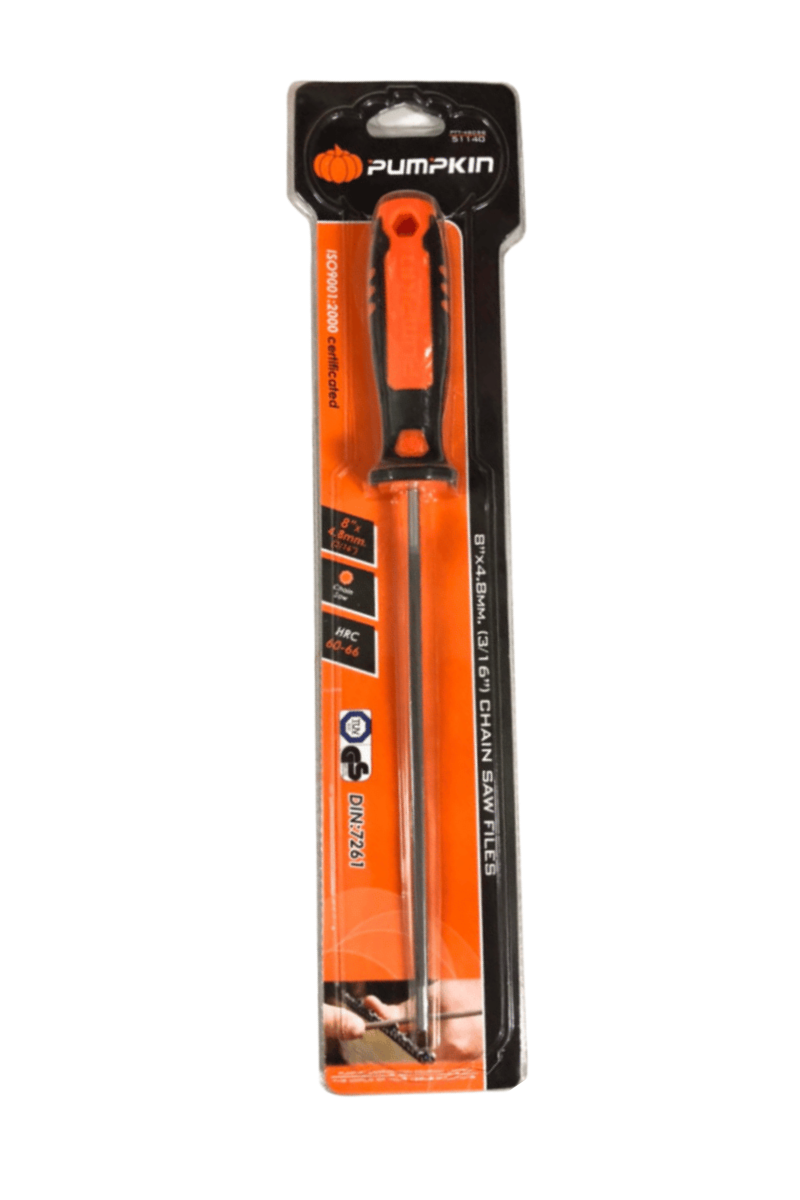 |
Ideal for:
- Chainsaw blade maintenance
- Woodworking that involves chainsaws
- Specifically designed for chainsaw sharpening
- Integrated handle
- Made from high-quality stee
2. PUMPKIN 6-inch Fine Round File (Model 51121)
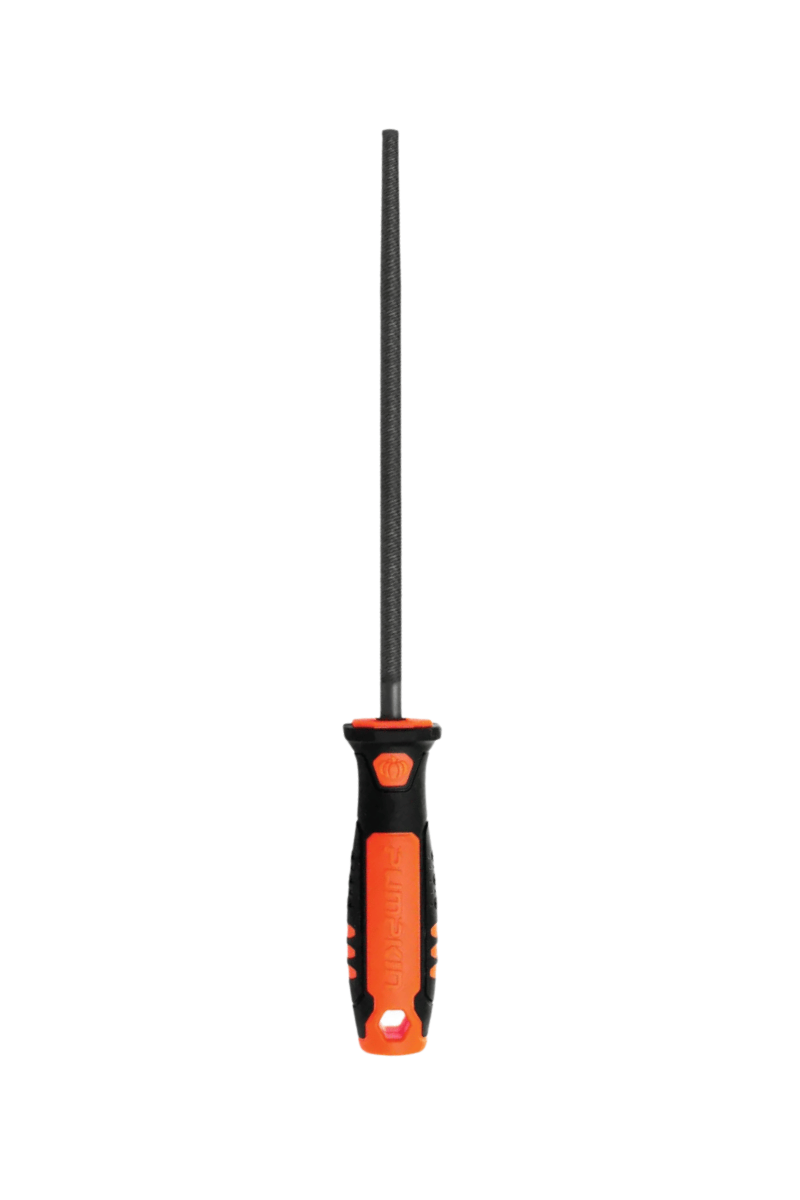 |
Ideal for:
- Refining holes
- Internal deburring
- Finishing curved workpieces
- Fine round file
- Made from T12 steel
- TPR handle (heat resistant)
3. PUMPKIN 6-inch Wood Rasp File with Handle (Model 51133)
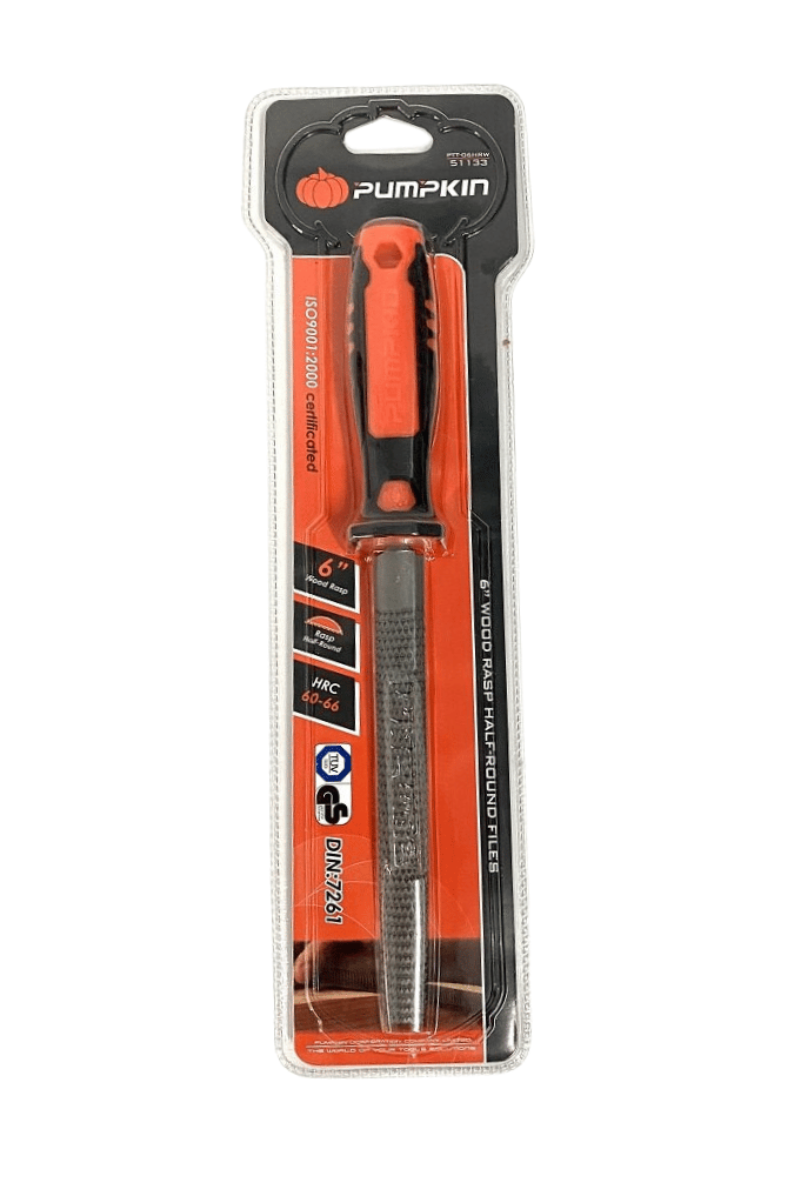 |
Ideal for:
- Shaping wood
- Metal
- Plastic
- Rapid material reduction
- Wood rasp file
- Coarse teeth
- TPR handle
- Versatile for various materials
4. PUMPKIN Fine Flat File with Handle (Models 51105 - 6 inch, 51106 - 8 inch, 51107 - 10 inch)
This fine flat file is a fundamental tool essential for general handyman work. Its fine cut makes it suitable for smoothing flat surfaces, deburring, or leveling workpieces. This model is available in various sizes to match your specific task requirements; longer files are better suited for wider surface areas.
Ideal for:- Smoothing flat surfaces
- Deburring
- General finishing tasks
- Leveling workpieces
- Fine flat file
- Available in multiple sizes
- Made from T12 steel
- TPR handle
5. PUMPKIN 8-inch Fine Half-Round File with Handle (Model 51114)
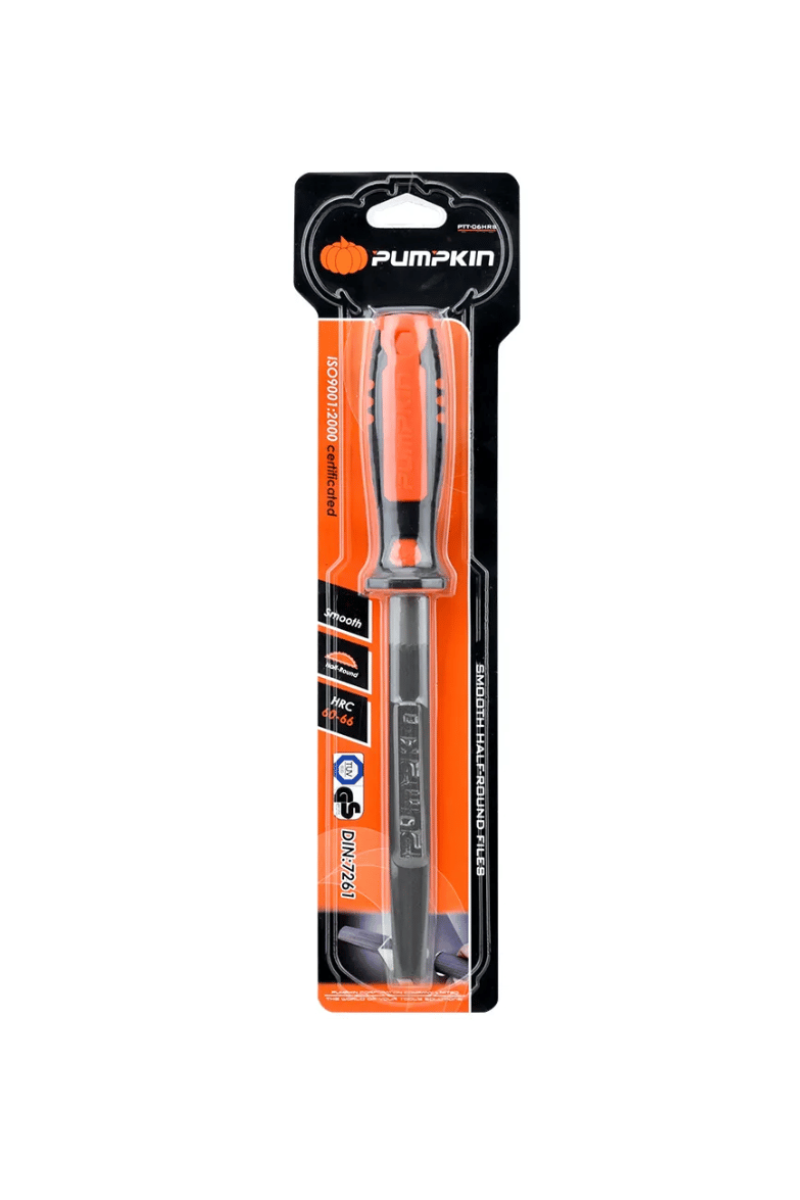 |
The half-round file features a semi-circular cross-section, with one side flat and the other curved. This design allows it to be used on both flat and finely curved surfaces. This particular model is a fine-cut file, perfect for meticulously finishing workpieces with intricate curves, such as refining curved wooden edges or enlarging oval-shaped holes.
Ideal for:- Fine finishing of curved surfaces
- Shaping curved workpieces
- Enlarging oval holes
- Half-round file
- Fine cut
- Works on both flat and curved surfaces
- TPR handle
6. PUMPKIN 6-inch Flat File with Handle (Model PTT-06FB 51101)
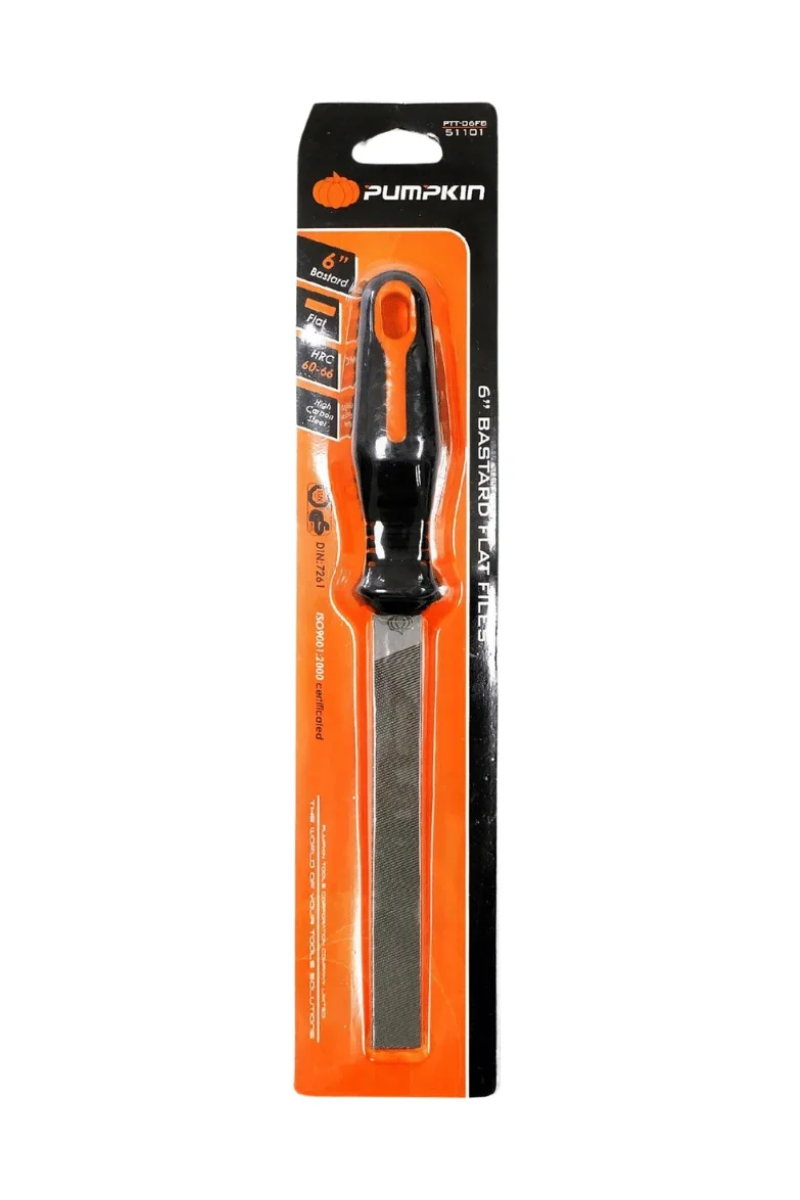 |
Ideal for:
- General handyman work
- Workpiece finishing
- Deburring
- DIY projects
Key Features:
- Flat file
- Excellent cutting edges
- Strong and non-slip handle
- Made from High Carbon Steel
Summary
Using a file correctly is an essential skill every craftsman should possess. It starts with choosing the appropriate file type for the material and the required finish, along with preparing the workpiece by securing it firmly, and consistently cleaning the file. Crucially, be aware of commonly overlooked precautions, such as neglecting file cleanliness, applying pressure on the backstroke, or improper storage. All of these factors affect the file's performance and the quality of your work. Implementing these principles will help you use files safely, achieve high-quality results, and extend the lifespan of your tools indefinitely.
Where to Purchase or Inquire About Products
For more information or to order products, visit Hardman, your comprehensive tool center, at Rama 3. Alternatively, you can send a message to their Facebook page inbox. Their team is ready to respond quickly and offers nationwide delivery
